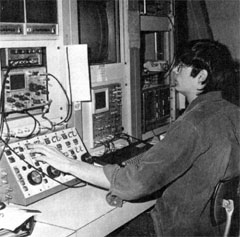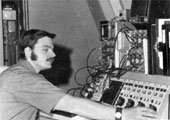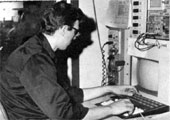Meet the NAL Accelerator Operators
PROGRESS ON ACCELERATOR STUDIES, JANUARY 24 - 28, 1972 Modifications were underway to achieve better acceleration based on operating experience. These included operating the quadrupoles and bends on the same power supply system to provide better regulation. Some beam tests were conducted. Beam studies resumed Thursday, January 27th.
"The backbone of our operation...they're the reason we've been able to get so much done... they've got to know everything...they're an aggressive and enthusiastic bunch.." and similar laudatory expressions were used by their leaders to describe the daily doings of the 17-man group of Accelerator Operators. Probably the highest compliment was the cry, "We need more just like them!"
An Accelerator Operator's main job is to tune and control the NAL accelerators from a centralized Main Control Room to ensure continuous and peak performance. He must have a detailed knowledge of the operation, maintenance and repair of the Cockcroft-Walton machine, the linear accelerator, the booster synchrotron, the beam transfer system, the main ring synchrotron and many other components - no small task!
It was almost impossible to find "experienced" operators for NAL's one-of-a-kind machine. The size of the mammoth machine was matched only by the enormous complexities that arose in its operation. And, as one senior physicist expressed it, "We're all still learning how to tame the beast!" So where does one get experience for such a job?
An Accelerator Operator is, typically, a person who with technical training or equivalent experience with a heavy emphasis upon electronics. But for every "typical" operator, there are several exceptions, both in training and education. Two of the early operators held B.S. degrees in physics; another attended Northern Illinois University. Jim Hogan, the operator's group leader, made every possible effort to adjust work schedules to accommodate the education plans of his crew.
A new operator learns by sitting at the control panel with an experienced operator; he observes, he asks questions, then tries by himself...pressing buttons and adjusting knobs at the console, watching for the results on the screens above. He must be able to interpret the data displayed on the console and to make continuous decisions for further adjustments. But when he doesn't obtain the results he's after, he would be expected to know alternative approaches. And, he should know where to go to correct a malfunction and, in many cases, how to fix it. He not only becomes sensitive to the operating idiosyncrasies of the machines, but becomes versatile in his ability to diagnose a problem and take appropriate action.
The personal qualities of the operators really determine their success. They need to demonstrate intellectual curiosity about everything technical in their path. An operator must have the interest, the confidence, and the drive to make electronic and mechanical systems work as they should. Also, they have a desire to make suggestions to improve the system and follow them through to completion. In short, "energetic dedication" describes the typical operator.
In 1972 three operators were needed on each of three shifts - one each on the Linac, the Booster, and the Main Ring consoles. When the system was completed and refined, one person would control the entire installation. To provide a change and to keep the men abreast of development work, they were rotated every five weeks through a "tech area" where they did bench work involving laboratory and systems equipment.
NAL leaders pointed out to prospective operators that a physics laboratory such as NAL is always pushing the limits of technical knowledge. Equipment is used at NAL was far ahead of what most industry usied and, as a result, the scope of the knowledge a person can learn in such an environment was almost unlimited. As a result, a well-motivated person working in the operator's group could be given a lot of responsibility and turned loose on a system that will give him a lot of challenge. If he responds to the challenge, he becomes a good operator.
Accelerator Operators in 1972 included: Barry Barnes, Michael Froehike, Jeff Gannon, Harland Gerzevske, Terry Hendricks, Robert Hively, David Kindelberger, Mark Koenig, Bill Lee, Ewald Macheel, Bob Mau, Keith Meisner, John Nelson, Gerry Ortlieb, Byron Rodewalt, Greg Urban, and Roy Wickenberg.
For the young student or ex-student with a bent for electronics and for being where the action is, the assignment as an NAL Accelerator Operator offered a 21st Century opportunity. Young female electronic wizards were also welcome for this challenging work.
(Photos in this article were taken by Tony Frelo and Tim Fielding, NAL Photographers.)







